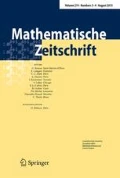1 Correction to: Math Z https://doi.org/10.1007/s00209-016-1807-6
We refer to our original paper, using the same notation.
We thank Jun-Muk Hwang for pointing out that the homomorphism of algebraic groups \(\eta :{\mathrm{GL}}({\mathcal {F}}^{\,\vee }_{2,x})_{{\mathcal {Q}}^\vee _x}\rightarrow {\mathrm{GL}}(T_{X,x})\) has a nontrivial kernel (isomorphic to \({{\mathbb {Z}}}_2\)), preventing us from defining, in Section 3.3, the vector bundles \({\mathcal {Q}}^\vee \), \({\mathcal {F}}_1^\vee \), \({\mathcal {F}}_2^\vee \). However, the main Theorem of the paper may still be proved by slightly modifying our arguments as follows.
1. In Section 3.3, instead of defining the vector bundles \({\mathcal {Q}}^\vee \), \({\mathcal {F}}_1^\vee \), \({\mathcal {F}}_2^\vee \) over X, we may only define the corresponding projective bundles \({\mathcal {Z}}\), \({\mathcal {U}}_1\) and \({\mathcal {U}}_2\) over X, and vector bundles \({\mathcal {G}}\), \(\mathrm{H}{\mathcal {G}}\) over \({\mathcal {U}}_1\), whose projectivizations give \({\mathcal {U}}\) and \(\mathrm{H}{\mathcal {U}}\), fitting in a sequence:
with \( {\mathcal {K}}\) a line bundle.
On the other hand, the desired vector bundles \({\mathcal {Q}}^\vee \), \({\mathcal {F}}_1^\vee \), \({\mathcal {F}}_2^\vee \) may still be constructed over a rational curve \(\ell \) of the family \({\mathcal {M}}\). By choosing an appropriate twist, they fit in the commutative diagram

for \(d=0\) or 1.
2. The computations in Section 4 can then be carried out in the same way, and they provide \({\mathcal {O}}(\mathrm{H}{\mathcal {U}}) \cdot \ell = d=0\).
3. To prove Corollary 5.2 we had used a result of Fujita, which no longer applies, since we do not have a divisor of degree one on the fibers of \(\rho \); however the conclusion of the Corollary is still true, since \(\rho \) is equidimensional, by applying [1, Theorem 1.3].
4. The main goal of Section 5 was to prove the existence of an everywhere nondegenerate skew-symmetric form on the vector bundle \({\mathcal {Q}}\), whose existence is now not clear. However, the arguments of the section provide, verbatim, the existence of an everywhere nondegenerate skew-symmetric form on the bundle \(\mathrm{H}{\mathcal {G}}\).
5. In section 6, we may now consider the \(\mathrm{A}_{r-1}\)-bundle \(\overline{{\mathcal {U}}}_1\rightarrow X\) associated to \({\mathcal {U}}_1\rightarrow X\) and the fiber product

Since \(\mathrm{H}{\mathcal {U}}\rightarrow {\mathcal {U}}_1\) is given by a cocycle with values in \({\mathrm{Sp}}({\mathcal {Q}}^{\,\vee }_x)\), by the results of Section 5, the same holds for \(\overline{{\mathcal {U}}}_1\times _{{\mathcal {U}}_1}{\mathrm{H}{\mathcal {U}}}\rightarrow \overline{{\mathcal {U}}}_1\), and we may construct its associated \(\mathrm{C}_{n-r}\)-bundle, \(\overline{\mathrm{H}{\mathcal {U}}}\rightarrow \overline{{\mathcal {U}}}_1\). Then the composition
is an \((\mathrm{A}_{r-1}\sqcup \mathrm{C}_{n-r})\)-bundle over X. From this point on, the proof goes on verbatim.
Reference
Höring, A., Novelli, C.: Mori contractions of maximal length. Publ. Res. Inst. Math. Sci. 49(1), 215–228 (2013)
Author information
Authors and Affiliations
Corresponding author
Additional information
Publisher's Note
Springer Nature remains neutral with regard to jurisdictional claims in published maps and institutional affiliations.
The original article can be found online at https://doi.org/10.1007/s00209-016-1807-6.
Rights and permissions
About this article
Cite this article
Occhetta, G., Solá Conde, L.E. & Watanabe, K. Correction to: A characterization of symplectic Grassmannians. Math. Z. 292, 569–570 (2019). https://doi.org/10.1007/s00209-019-02230-y
Published:
Issue Date:
DOI: https://doi.org/10.1007/s00209-019-02230-y

